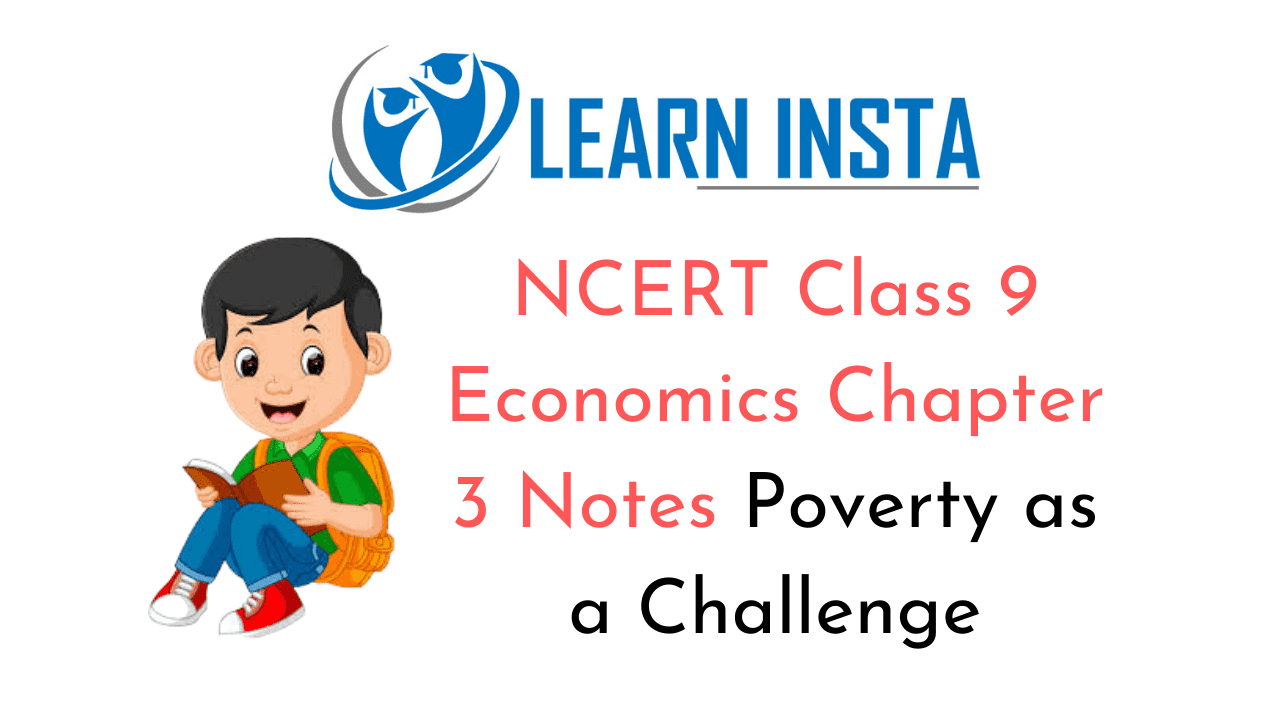
On this page, you will find NCERT Class 9 Economics Chapter 3 Notes Pdf free download. CBSE Class 9 Social Science Notes Economics Chapter 3 SST Poverty as a Challenge will seemingly, help them to revise the important concepts in less time.
Poverty as a Challenge Class 9 Notes Social Science Economics Chapter 3
CBSE Class 9 Economics Chapter 3 Notes Understanding the Lesson
1. Poverty is a major challenge faced by independent India. It has many dimensions, normally, this is measured through the concept of ‘Poverty line’.
2. A common method used to measure poverty is based on the income or consumption levels. A person is considered poor if his or her income or consumption level falls below a given ‘minimum level’ necessary to fulfil basic needs.
3. What is necessary to satisfy basic needs is different at different times and in different countries. Therefore, poverty line may vary with time and place.
4. While determining the poverty line in India, a minimum level of food requirement, clothing, footwear, fuel and light, educational and medical requirement, etc; are determined for subsistence.
5. These physical quantities are multiplied by their prices in rupees. The present formula for food requirements while estimating the poverty line is based on the desired calorie requirement.
6. The calorie needs vary depending on age, sex and type work that a person does. The accepted average calorie requirement in India is 2400 calories per person per day in rural areas and 2100 calories per person per day in urban areas.
7. For the age 2011-12, the poverty line for a person was fixed at ? 816 per month for the rural areas and? 1000 for the urban areas.
8. In the year 2011-12, a family of five members living in rural areas and earning less than about? 4,080 per month will be below the poverty line. A similar family in urban areas would need a minimum of ? 5,000 per month to meet their basic requirements.
9. The poverty line is estimated periodically by conducting sample surveys which are carried out by the National Sample Survey Organisation (NSSO).
10. There is substantial decline in poverty ratios in India between 1993-94 and 2004-05 but the number of poor remained at about 407 million which further declined to 269 million in 2011-12.
11. The social groups which are most vulnerable to poverty are scheduled caste and scheduled tribe households. Among the economic groups, the rural agricultural labour households and the urban casual labour households are the most vulnerable groups. In poor families, women, elderly people and female infants are considered poorest of the poor.
12. The proportion of poor people is not the same in every state of India. Bihar and Odisha continue to be the two poorest states with poverty ratios of 33.7 and 37.6 per cent respectively.
13. In states like Kerala, Jammu and Kashmir, Andhra Pradesh, Tamil Nadu, Gujarat and West Bengal there has been a significant decline in poverty. States like Punjab and Haryana have also succeeded in reducing poverty to a great extent.
14. There has also been a substantial reduction in global poverty. But it is marked with great regional differences. Poverty declined substantially in China and Southeast Asian countries but in countries of I South Asia i.e. India, Pakistan, Sri Lanka, Nepal, Bangladesh and Bhutan, the decline has not been rapid.
15. In Sub-Saharan Africa, poverty rose from 51 per cent in 1981 to 47 per cent in 2008. In Latin America, the ratio of poverty remained the same.
16. The causes of widespread poverty in India are—the low level of economic development under the British colonial administration, high growth rate of population, huge income inequalities and sociocultural and economic factors.
17. Removal of poverty has been one of the major objectives of Indian developmental strategy. The government is focusing on the promotion of economic growth. It has also started many anti-poverty schemes/programmes.
18. There are many schemes which are formulated to affect poverty directly or indirectly. Some of them are – Mahatma Gandhi National Rural Employment Guarantee Act, (MGNREGA), Prime Minister Rozgar Yozana (PMRY), Rural Employment Generation Programme (REGP), Swarnajayaanti Gram Swarozgar Yozana (SGSY), Pradhanmantri Gramodaya Yozana (PMGY), and Antyodaya Anna Yozana (AAY).
19. Poverty has certainly declined in India. But poverty reduction is still India’s most compelling challenge. Poverty reduction is expected to make better progress in the next ten to fifteen years.
20. Even though we will be able to provide the minimum necessary in terms of income to all people by the end of the next decade, but the target will move on for many of the bigger challenges that still remain. For example, providing health care, education and job security for all and achieving gender equality and dignity for the poor. These are some of the issues which also need to be focused.
Poverty as a Challenge Class 9 CBSE Notes Important Terms
Poverty: The state of being extremely poor.
Poverty line: The estimated minimum level of income needed to secure the necessities of life.
Challenge: Something that needs great mental or physical effort in order to be done successfully and therefore tests a persons’ ability.
Human poverty: A situation in which people have food, clothing and shelter but don’t have proper education, self-confidence, gender equality and dignity.
Poverty alleviation: Removal of poverty.